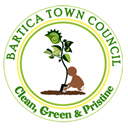His Excellency President David A. Granger has espoused and sought to encourage the pursuance of Green Economy as a development paradigm for Guyana, since coming to power in May 2015. This trajectory builds on the Low Carbon Development Strategy (LCDS) developed and promoted under the last political Administration, but seeks a more comprehensive outreach in its outlook. Within this framework effective land use planning, energy security, water security, and waste management, inter alia, are delineated.
Bartica, has been designated the model town for Green Initiatives. This project is located within the agenda of the Green Economy Framework in lieu of Guyana’s overarching sustainable development architecture, and hence as a small state subject to the vicissitudes of the global climate and economy, treats environmental security as a key development issue.
Clean energy solutions supported by behavioral changes in Bartica are pivotal to reducing its local energy intensity and promoting economic and social development far beyond the boom-bust cycles associated with the gold mining industry.
The only major supplier of electricity in Bartica is the state-owned Guyana Power and Light (GPL) Company which is also responsible for transmission and distribution. The company operates two diesel generating sets with a name plate capacity of 2.8 megawatts (MW) and a nominal capacity of 2.4 megawatts (MW). On an annualized basis, these sets combined consume a total of approximately 700 000 gallons, injecting approximate 13.745 million pounds of carbon dioxide (CO2) into the atmosphere. While Guyana’s carbon footprint is minuscule with regards to the global climate budget1, it is imperative that under the country’s commitment under the Paris Agreement, concomitant with the realization of its National Designated Contributions (NDCs), that these types of initiatives be encouraged, fostered and pursued forthwith. Moreover, with the country spending more than 20% annually of its export earnings on imported fossil fuel, and households more than 15% of their disposal income (Second National Communications, 2015), these are resources that can be used towards building long term development resilience.
In addition, transportation both by road and river are the primary means of mobility in Bartica.
However, there still remains a need for accurate and verifiable data in this regard.
Transitioning Bartica from a 100% fossil fuel based economy to more reliance on clean energy generation is highly possible but will largely be dependent in the first instance on accurate baseline data collection and management, capacity building and knowledge transfer of renewable energy information and techniques.
Indeed emerging technological changes offer huge possibilities for modernizing and moving Bartica towards a “Green economy”; encourage a future where technology and society will be familiar to new needs; techniques and innovations, thereby creating new opportunities.
Adopting improved technology and techniques may also stimulate the development of a large leading-edge market for energy, enabled best practices that will foster the competitiveness within these sectoral spaces and create new business opportunities.
Today, because sustainable energy is pervasive to all sectors and business domains, their modern application is expected to register a lasting impact in the future of sustainable development and livelihood for the new Bartica Township.
It is clear that, if Bartica is to succeed and achieve this ambitious objective, the role of sustainable energy as an enabler of sustainable development and sustainable livelihood needs to be fully explored and exploited.
This project is considered critical to the stimulation and wider uptake of the much needed alternative energy solutions alternatives for Bartica, bearing important implications for its new developmental plans and transition towards a model “Green Town”, much for the greater good of a national Green Economy.
